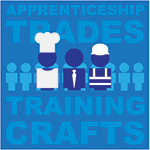 Apprenticeships are a popular method of training for crafts people in Ireland. Aimed at developing the skills needed to meet the requirements of the labour and industry market, the main craft trades are the construction sector, electrical sector, motor sector, engineering sector and printing sector. The training is regulated by legislation and FÁS/Solas is currently the regulatory body.
Apprenticeships are a popular method of training for crafts people in Ireland. Aimed at developing the skills needed to meet the requirements of the labour and industry market, the main craft trades are the construction sector, electrical sector, motor sector, engineering sector and printing sector. The training is regulated by legislation and FÁS/Solas is currently the regulatory body.
On May 19th this year the Minister for Education, Ruairí Quinn, announced a review of apprenticeships in Ireland so as to develop more of a focus on work-based learning and on the current needs of the labour market. A review group has been created to work on the changes and there is a request from the Department of Education for submissions from organisations or people who have an interest in the area.
While there are some benefits of the current apprenticeship model, such as the high levels of satisfaction between learners and employers within the programme and the provision of an alternative path to higher education for those who may not have completed their leaving certificates, there are drawbacks to the existing model too. Costs when compared to international apprenticeship programmes, the economic downturn leaving many apprentices without the employment they need to complete their course, the limited choice of apprenticeships and the fact that 85% of the current apprenticeships are construction based, are just some of the failings that the government are hoping to address with this review.
On September 27th, the Higher Education Authority (HEA) submitted a document to the Apprentice Review Group, outlining areas for consideration and mentioning two key areas they feel are essential for a successful apprenticeship programme. The first concerns the role of employers; that they are best at determining occupations where the apprenticeship is the best training method, the vocational content and the skills necessary for such employment. The second refers to the ability of the educational and training sector to develop apprenticeship programmes fit for purpose. The HEA are keen to develop a strong partnership between the educational sector and employers so that the two can work together and support economic recovery by providing people with adequate skills for the current jobs market.
The HEA have 25 recommendations some of which are:
• Employers identifying areas suitable for apprenticeship trainings and therefore broadening the current range of choice and better serving the labour market of today.
• Qualifications on completion of an apprenticeship being at any level of the NFQ appropriate to the learning outcomes.
• All the apprenticeships containing transferable skills.
• Distance education forming part of the training as well as alternate periods on and off the job.
• No age or gender limitations on entering but the number of recruits being determined by employment and economic predictions.
The HEA state that by implementing these reforms, future apprentices will be able to achieve their maximum potential and be successful when entering into the labour market.
Current high levels of unemployment in Ireland demonstrate the urgent need for improvement in the education system. The conversion of FÁS into SOLAS, the change from VECs to ETBs and now the review of the apprenticeship scheme are all signs that the government is responding to this need for change. A move away from limited training for jobs that no longer exist, towards a broader selection of apprenticeships that reflect the labour market needs are positive steps towards a more effective education and training system.
Author
Fiona McBennett